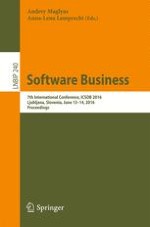This book contains the refereed proceedings of the 7th International Conference on Software Business, ICSOB 2016, held in Ljubljana, Slovenia, in June 2016. Software business refers to commercial activities in and around the software industry aimed at generating income from the delivery of software products and services. The theme of the event was "Software as a New Way of Providing Cutting-edge Solutions".
The 10 full and 5 short papers for ICSOB were selected from 38 submissions. The papers span a wide range of issues related to contemporary software business, ranging from strategic aspects to operational challenges. The strong presence of software ecosystem papers confirms the importance of this topic and influence on software business. In addition, a short abstract of the key note by Peter Lick and Hans-Bernd Kittlaus is also included.
